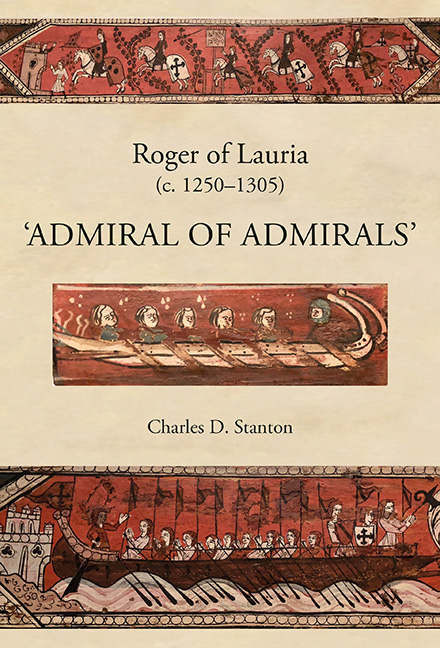Book contents
- Frontmatter
- Dedication
- Contents
- List of Illustrations
- Prologue
- 1 Battle of Benevento (26 February 1266)
- 2 A Calabrian Exile in the Court of Aragon (1262–1282)
- 3 Battle of Tagliacozzo (23 August 1268)
- 4 Aragonese Expansion (1229–1282)
- 5 Angevin Consolidation and Aggrandizement (1268–1282)
- 6 Revolt of the Vespers (30 March 1282)
- 7 Aragonese Intervention (August–October 1282)
- 8 Stalemate (November 1282–March 1283)
- 9 Admiral of Aragon (20 April 1283)
- 10 The Opposing Fleets (1282–1302)
- 11 Battle of Malta (8 June 1283)
- 12 Anjou's Dreams of Empire Dashed (June–November 1284)
- 13 France's Crusade Against Aragon (May–November 1285)
- 14 Battle of the Counts (23 June 1287)
- 15 Truces and Treaties (June 1287–November 1291)
- 16 Raid on Romania (Summer 1292)
- 17 Switching Sides (December 1293–April 1297)
- 18 Aragon's Invasion of Sicily at Anjou's Bidding (1298/1299)
- 19 Lauria's Last Great Campaign (Summer 1299–Spring 1300)
- 20 Endgame (Spring 1301–Summer 1302)
- Epilogue
- Bibliography
- Index
4 - Aragonese Expansion (1229–1282)
Published online by Cambridge University Press: 24 October 2019
- Frontmatter
- Dedication
- Contents
- List of Illustrations
- Prologue
- 1 Battle of Benevento (26 February 1266)
- 2 A Calabrian Exile in the Court of Aragon (1262–1282)
- 3 Battle of Tagliacozzo (23 August 1268)
- 4 Aragonese Expansion (1229–1282)
- 5 Angevin Consolidation and Aggrandizement (1268–1282)
- 6 Revolt of the Vespers (30 March 1282)
- 7 Aragonese Intervention (August–October 1282)
- 8 Stalemate (November 1282–March 1283)
- 9 Admiral of Aragon (20 April 1283)
- 10 The Opposing Fleets (1282–1302)
- 11 Battle of Malta (8 June 1283)
- 12 Anjou's Dreams of Empire Dashed (June–November 1284)
- 13 France's Crusade Against Aragon (May–November 1285)
- 14 Battle of the Counts (23 June 1287)
- 15 Truces and Treaties (June 1287–November 1291)
- 16 Raid on Romania (Summer 1292)
- 17 Switching Sides (December 1293–April 1297)
- 18 Aragon's Invasion of Sicily at Anjou's Bidding (1298/1299)
- 19 Lauria's Last Great Campaign (Summer 1299–Spring 1300)
- 20 Endgame (Spring 1301–Summer 1302)
- Epilogue
- Bibliography
- Index
Summary
IT WAS, IRONICALLY, Charles of Anjou's conquest of the Kingdom of Sicily that put him on a collision course with another emerging Mediterranean power: the Crown of Aragon. At precisely the moment that Anjou was establishing a dominant position in the centre of the Middle Sea, Aragon was in the process of an aggressive eastward expansion that would eventually foist it into direct conflict with Angevin interests and introduce Anjou to the admiral who would ultimately end his aspirations of empire.
Like the Kingdom of Sicily, the Crown of Aragon (as it was commonly known) was a relatively new realm (Map 5). As fortune would have it, they were both established at about the same time – in the early twelfth century. The former was founded on 27 September 1130 when Pope Anacletus II issued a papal bull recognizing Roger II de Hauteville as king of Sicily, and the latter was effectively born on 11 August 1137 with the betrothal of Count Ramon Berenguer IV of Barcelona to the Infanta Petronilla of Aragon. And both were destined to become sea powers – Sicily because it was an island kingdom and the Crown of Aragon because its Catalonian component was centred on the vibrant port city of Barcelona. But the two kingdoms did not clash in any significant manner prior to the thirteenth century, largely owing to the fact that Catalonian maritime expansion was impeded by Moorish-held Majorca (Mallorca) and Menorca (Minorca) in the Balearics, which stood astride the trade routes to North Africa and the eastern Mediterranean. All that changed shortly after the accession of James I to the throne of Aragon on 12 September 1213.
CONQUEST OF MAJORCA BY JAMES I (1229–1231)
Prior to James's coronation, Aragon had been dominated by twelve noble families whose primary ambition comprised extending their power southward into the Muslim-controlled portion of the Iberian peninsula – particularly the kingdoms of Valencia and Murcia. This served as an additional brake on Catalonia maritime penetration into the Mediterranean. But James and his successors realized that the Crown of Aragon's inherent lack of resources severely restricted its potential for aggrandizement at the expense of its Muslim neighbours.
- Type
- Chapter
- Information
- Roger of Lauria (c.1250–1305)‘Admiral of Admirals’, pp. 48 - 65Publisher: Boydell & BrewerPrint publication year: 2019

